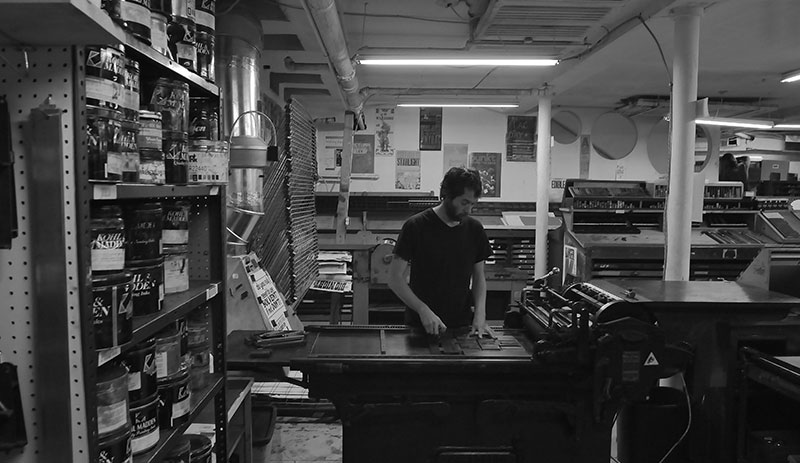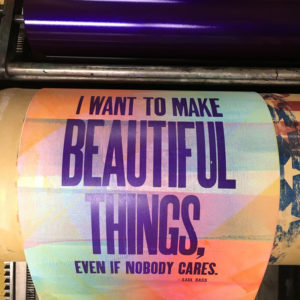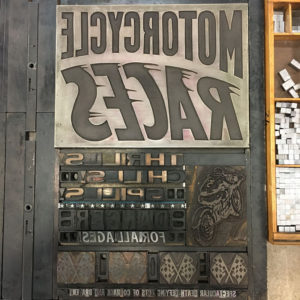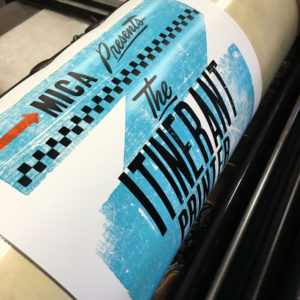
interview by Katy Ibsen, managing editor
PostPress
 Chris Fritton, author of The Itinerant Printer, a 12″x12″-coffee table book that commemorates his two-and-a-half-year travels to 137 letterpress print shops across the United States and Canada, has become a curiosity-seeker in the world of letterpress.
Chris Fritton, author of The Itinerant Printer, a 12″x12″-coffee table book that commemorates his two-and-a-half-year travels to 137 letterpress print shops across the United States and Canada, has become a curiosity-seeker in the world of letterpress.
Better classified as a tramp printer, Fritton used his journey to discover the vast world of letterpress from regional, economic, historic and creative vantages (as exhibited in his 320-page book).
In this interview, Fritton shares information gathered during his capstone project and information on how letterpress on a commercial level can elevate brands in unexpected ways, including the various avenues in which letterpress currently intersects with brands and commercial use.
Letterpress as a compelling form of printing
There’s something about physically building the words that makes them more meaningful. Beyond its appeal as a constructive medium, I’m excited about the myriad unexplored possibilities in letterpress – it isn’t the most popular medium, and that means it’s still ripe for a lot of experimentation and play.
Letterpress as a desired medium among commercial brands
Letterpress had a resurgence, I think, as a reaction to digital media. People, including designers themselves, were feeling very removed from their products and their modes of production. In the end, the pendulum swung back in the opposite direction, away from the clean, hygienic, sterile space of digital graphic design toward the grittier, more visceral and haptic world of letterpress.
It isn’t just what’s become popular; i.e., a deep impression on soft cotton paper that announces itself as handmade. It’s also the boundless repository of visual information. There are so many millions of images and fonts that have never been digitized, and all of that visual information is just begging to be used.
I think (letterpress for commercial use is) good in the short term, but it might pose a challenge in the long term.
When something trends, whether it’s a medium or a style, it is susceptible to becoming a novelty, and a novelty grows old and gives way to the next big thing. Whether it’s big, blocky wood type or detailed metallic foil, its day will come and something new will be waiting to take its place. The thing that I like most about seeing more letterpress printing commercially is that it puts pressure on innovators and visionaries – it makes all of us work harder to figure out what’s coming next.
Using letterpress to make a statement
It’s an unpopular thing for me to say, as a letterpress printer, but I use letterpress printing because it’s the medium I have the most facility with – if another medium would give me better results, I’d use it. And I’d advise that for anyone, and I think most tradespeople would immediately see the wisdom in that.
But I’d also say letterpress just doesn’t look like anything else in the world. It’s not only tactile, but also visually arresting and challenging. Many people come away from looking at a letterpress piece wondering how it was made. That’s what I love about it – it draws you in and makes you ask questions about its origins. That kind of work will start thousands of conversations.
Managing client expectations with letterpress
This is definitely a challenge. As letterpress went from commonplace to uncommon to almost obsolete, it left the common consciousness. What makes it intriguing now, as I said before, is our lack of familiarity with it. But, that lack of familiarity also is a huge obstacle, one that requires a lot of education. You have to take the time to explain, sometimes even demonstrate, how the pieces are made in order to convey a sense of value to the client. I think once you’ve invited people into that space, they come away with a greater understanding of why the pieces are special and they’re also more forgiving of idiosyncrasies based on the handmade nature of the product.
Letterpress trends

Integration of new technologies! Some of the best printers that I know all across the world are using laser cutters, 3D printers, CNC routers and more to create blocks, plates, stencils and type for printing. I believe there are endless possibilities in merging digital and analog – it’s never helpful to think of them as mutually exclusive – and the most forward-thinking printers see them as working hand-in-hand. Recently, in addition to this convergence, I’ve been seeing trends toward more abstract, painterly work – pieces that use type, plates and even the presses in new ways. It’s all about imagining how else the tools at your disposal can make a mark on the page.
The value of printed matter

I’ve been thinking about this a lot lately – recently, at an exhibition I did in Boston, dozens of people came “because they saw the poster hanging up” somewhere. It was really eye-opening. A good visual message does its job regardless of the medium, but in our increasingly digital surroundings, there’s something more compelling about a handmade object – it’s like it’s an artifact from a bygone era living in the present, and in many ways, because it’s an anachronism, it does its job better than it would’ve 100 years ago when it was drowning in reams of other printed matter. I also believe humans are inherently attracted to physical objects; there’s an intimacy that we cultivate with them, a closeness that we can’t replicate with digital information – call it romantic, but I think, at the end of the day, we still want something to hold in our hands.
In January 2015, Chris Fritton began traveling the US and Canada to visit small, obscure and unique letterpress shops in an effort to learn more about the medium he had come to love. During his two-and-a-half year journey, he visited 137 letterpress print shops covering more than 47,000 miles and making over 15,000 prints. His journey is chronicled in his new book, The Itinerant Printer.
The Itinerant Printer’s Letterpress Tips
After visiting 137 letterpress studios across the US and Canada, Chris Fritton, author of The Itinerant Printer, shares his tips for working in letterpress.
Baby wipes. Use baby wipes for cleaning your hands! Baby wipes have a tiny bit of baby oil on them, and that acts as a solvent for most inks. Instead of running to the sink to wash up every five minutes, just wipe down and keep working.
Scotch tape. Use Scotch tape for makeready, not masking tape or painter’s tape. Masking tape has goopy adhesive that gets left behind, and both tapes are too thick to build up makeready slowly. Scotch tape is thin, clean and the transparency really comes in handy sometimes.
Post-It Note. When you’re doing makeready with wood type and you need to slip a sheet of paper under a sort, use a Post-It Note. It already has a little built-in adhesive, and if you have to move it again, your shim will move with the type instead of getting lost.
String. When you’re using a flat drying rack, be sure to run string or twine down the back of it vertically about every 6″ – that way if the racks get lifted accidentally, the prints won’t slide out the back onto the floor.
Paint the end of your furniture correspondent to its length for quick and easy sorting back into the case (yellow for 10 pica, green for 15 pica, etc.).
Get a tackle box. Sort your letter spacing for metal type into fishing tackle cases by size instead of leaving it in California job cases. It makes finding the right spacing faster and easier, especially when you’re dealing with really old cases that could have decades-old assortments of spacing.

